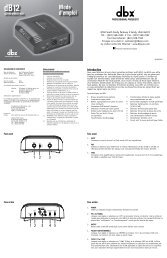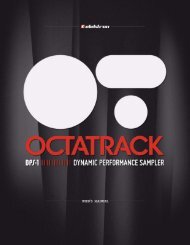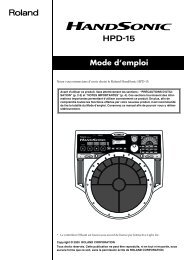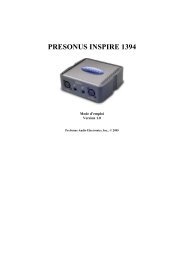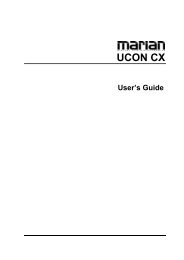1642-VLZ3 16-Channel Mic/Line Mixer Owner's Manual
1642-VLZ3 16-Channel Mic/Line Mixer Owner's Manual
1642-VLZ3 16-Channel Mic/Line Mixer Owner's Manual
You also want an ePaper? Increase the reach of your titles
YUMPU automatically turns print PDFs into web optimized ePapers that Google loves.
Another method of interfacing a multitrack is called<br />
in-line monitoring, and requires a mixing console<br />
dedicated to that, like the Mackie 8•Bus. Each of its<br />
channels is actually two channels: one carrying the mic/<br />
line sound source and the other carrying the multitrack<br />
output.<br />
6. AUX SEND OUTPUTS<br />
These 1/4" jacks usually patch to the inputs of your<br />
parallel effects devices or to the inputs of your stage<br />
monitor amps. To learn how signals are routed to these<br />
outputs, see the Aux discussion on page 21.<br />
8. SUB OUTS<br />
These 1/4" jacks are usually patched to the inputs of a<br />
multitrack deck, or to secondary amplifiers in a complex<br />
installation. See page 18 for details of the SUBGROUP<br />
FADERS [38]. (See also the discussion on double busing<br />
on the previous page.)<br />
9. C-R OUTS (CONTROL ROOM OUTPUTS)<br />
These 1/4" jacks are usually patched to the inputs of<br />
your control room amplifier or a headphone distribution<br />
amplifier. See page 19, CONTROL ROOM and PHONES<br />
[43] for details of the signal routing to these outputs.<br />
Owner’s <strong>Manual</strong><br />
EFFECTS: SERIAL OR PARALLEL<br />
You’ve heard us carelessly toss around the terms “serial”<br />
and “parallel.” Here’s what we mean by them:<br />
“Serial” means that the entire signal leaves the mixer<br />
(INSERT send), is routed through the effects device,<br />
and returns to the mixer (INSERT return). Examples:<br />
compressor, limiter, graphic equalizer. <strong>Line</strong>-level<br />
sources can also be patched through a serial effects<br />
device before or after the mixer.<br />
Dry Signal<br />
Dry Signal(s)<br />
Insert<br />
Send<br />
Aux<br />
Send<br />
Signal Processor<br />
(e.g., Compressor)<br />
Signal Processor<br />
(e.g., Reverb)<br />
<strong>Channel</strong> Path<br />
Insert<br />
Return<br />
Aux<br />
Return<br />
Wet Signal<br />
Dry Signal(s)<br />
Output<br />
Section<br />
Mix<br />
Stage<br />
Processed<br />
Signal<br />
“Parallel” means that a portion of the signal in the<br />
mixer is tapped off to the device (AUX SEND), processed,<br />
and returned to the mixer (STEREO RETURN)<br />
to be mixed with the original “dry” signal. This way,<br />
multiple channels can all make use of the same effects<br />
device. Examples: reverb, digital delay.<br />
Processed<br />
Signal<br />
7. STEREO RETURN INPUTS<br />
This is where you connect the outputs of your parallel<br />
effects devices (or extra audio sources). There are four<br />
stereo returns. They’ll accept just about any pro or semipro<br />
effects device on the market. See page 22 for details<br />
of the STEREO RETURN [51] level controls.<br />
Mono: If you have an effects device with a mono<br />
output (one cord), plug that into the left input of a<br />
STEREO RETURN and leave the right input unplugged.<br />
That way, the signal will be sent to both sides, magically<br />
appearing in the center as a mono signal.<br />
10. PHONES OUTPUTS<br />
These stereo 1/4" phones<br />
jacks will drive any standard<br />
headphone to very<br />
loud levels. Walkpersontype<br />
phones can also be<br />
used with an appropriate<br />
adapter. See page 19, CON-<br />
TROL ROOM and PHONES<br />
[43] for details of the<br />
signal routing to these outputs.<br />
10<br />
If you’re wiring your own cable for the PHONES output,<br />
follow standard conventions:<br />
Tip = left channel<br />
Ring = right channel<br />
Sleeve = common ground<br />
WARNING: When we say the headphone<br />
amp is loud, we’re not kidding. It can cause<br />
permanent ear damage. Even intermediate<br />
levels may be painfully loud with some earphones. BE<br />
CAREFUL!<br />
Always turn the PHONES knob all the way<br />
down before connecting headphones. Keep<br />
it down until you’ve put the phones on. Then<br />
turn it up slowly. Why “Engineers who fry their ears<br />
find themselves with short careers.”<br />
Owner’s <strong>Manual</strong><br />
11






